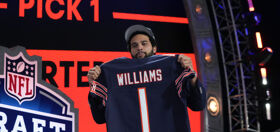 There’s a new graph making the rounds on social media right now (yes, that’s right, we live in the world where statistical illustrations have the power to go viral). It shows several years of Pew polling on marriage equality across several age groups. And no surprise: support’s been climbing quickly for the last few years.
There’s a new graph making the rounds on social media right now (yes, that’s right, we live in the world where statistical illustrations have the power to go viral). It shows several years of Pew polling on marriage equality across several age groups. And no surprise: support’s been climbing quickly for the last few years.
But why? What happened to hasten the growth in support? It’s a phenomenon that’s observable across multiple age demographics: Whether you were born in the 1920s or 1990s, you’re more likely to support marriage equality than you were at the start of the millennium.
There’s a small climb in support around 2004, and a bigger push around 2009. That provides a few clues to what happened. Our theory is that there were three social phenomena that pushed support:
First, there was a change in social visibility. In 2004, Massachusetts was the first state to legalize the freedom to marry. George Bush called for a constitutional ban on marriage, and Gavin Newsom responded by issuing licenses in San Francisco. That meant a surge in public awareness of gay and lesbian couples. The same thing happened in 2009, when we saw a ton of media coverage post-Prop. 8, and when Iowa legalized marriage, and several New England states.
How about we take this to the next level?
Our newsletter is like a refreshing cocktail (or mocktail) of LGBTQ+ entertainment and pop culture, served up with a side of eye-candy.
Next, there was a change in social attitudes, driven in part by the social policy. As we’ve consistently seen, people are more likely to support equality when they see the people affected. And when they see that marriage equality doesn’t mean the end of the world, their resistance starts to melt away. Over the last decade, Americans have grown increasingly accustomed to seeing loving stable LGBT couples around them in real life and in the media. We’re just part of the landscape now.
And third, there was social media. (We presented a panel on this topic at SXSW.) Friendster was just getting off and running around 2004, and by 2008 social media was embedding in everyone’s life. Technology that allows us to forge interpersonal relationships helped advance the equality movement in two ways: first, it meant that straight people were seeing more of the gay people in their lives. Suddenly, we didn’t seem so alien. And second, LGBT people were seeing more of each other, which meant that we had a greater awareness of our own community. No longer were we stuck in whatever gay ghetto we happened to inhabit: suddenly, it was a lot easier to see gays of different ethnicities, faiths, ages, and occupations. And that made it easier for us to work together towards a common cause.


















Cam
Also remember, for ages groups like HRC could suck all the air out of the room on gay issues. Every media outlet would go to them and only they got press. They demanded that gays never say anything to democrats because they were our friends and gay issues were a losing issue.
Using social media grass roots took the discussion away from HRC, put pressure on the democrats and we had a HUGE amount of movement on gay issues within the year.
rand503
Absolutely. Perhaps people don’t remember, but there is a period of time with HRC’s chairman refused to argue in favor of gay rights at all. I forgot her name, but in the 2000 elections they did all these focus groups which told them that people wanted to hear about healthcare issues not gay issues. And so, whatever HRC was invited on any TV panel to discuss gay issues, they actually really refused to address same-sex marriage or any other issues, instead saying people want to talk about health care. So we literally have no one advocating our side at the same time that all these religious groups were attacking us.
When Bush got elected that Chairman got fired, thank God. But that we have the whole debacle of proposition eight in California, where the gay groups refuse to use the word same-sex marriage, or gay marriage, fact they were terrified of using the words gay homosexual at all! Instead, they they kept using vague language such as equality and fairness for all people, hardly ever even mentioned the word marriage. Again, that left it to the hate groups to define gay marriage something evil.
Now with social media, these big gay groups like HRC cannot control the message. That’s a good thing!
Cam
@rand503:
I think that was Elizabeth Birch? People like her and Joe Solomnase seemd to fear anything gay far more than the right wing religious bigots.